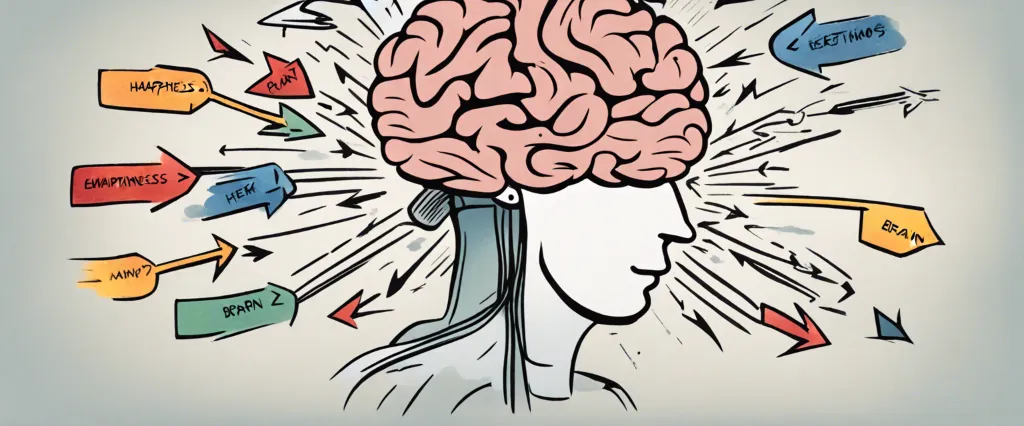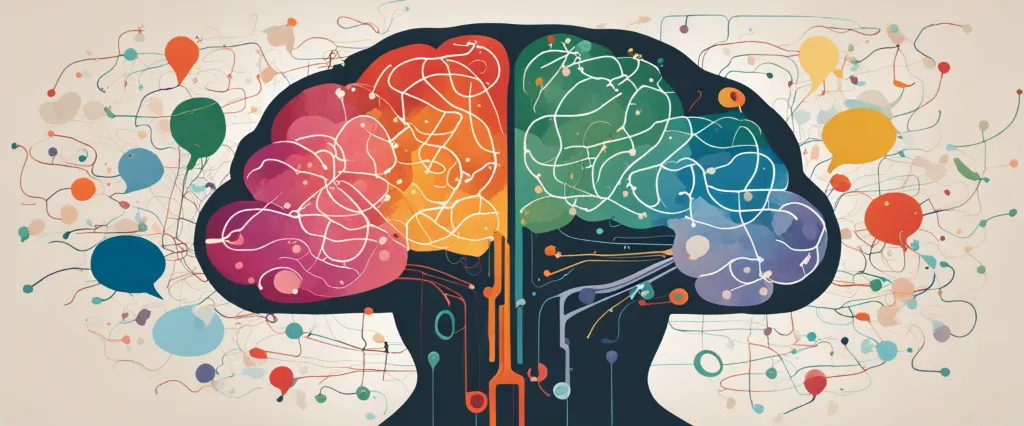In “The Emotional Life of Your Brain,” acclaimed neuroscientist Richard J. Davidson unravels the innermost workings of our emotions, providing a groundbreaking perspective on their impact on our mental, physical, and social well-being. Drawing on decades of research, Davidson presents a revolutionary approach to understanding and harnessing our emotions, offering practical exercises and insights to help us cultivate a healthier emotional life. With expertise spanning the fields of psychology and neuroscience, Davidson is uniquely positioned to enlighten readers on the intricate interplay between emotions, brain activity, and our overall well-being. As the founder of the Center for Healthy Minds at the University of Wisconsin, Madison, his pioneering work has deeply influenced the realm of emotional well-being. Davidson’s groundbreaking findings have been extensively featured in prestigious scientific journals and mainstream media outlets, cementing his reputation as a leading authority on the emotional complexities of the human brain.
Chapter 1: Introduction to Emotional Life and the Brain
Chapter 1: Introduction to Emotional Life and the Brain of The Emotional Life of Your Brain by Richard J. Davidson provides an overview of the book’s foundational concepts and introduces the reader to the author’s groundbreaking research on the neuroscience of emotions. Davidson is a renowned neuroscientist specializing in the study of emotions and their impact on brain function.
The author starts by establishing the importance of emotions in our lives, highlighting their influential role in shaping our experiences, decision-making, physical health, and overall well-being. He argues that understanding the neural underpinnings of emotions is crucial for unlocking our full potential for happiness and personal growth.
Davidson then introduces the concept of emotional styles, which are recurring patterns in how individuals experience and regulate their emotions. He asserts that these styles are not fixed traits but rather can be altered through intentional training and practice. By examining the different emotional styles, the author aims to help readers gain self-awareness and identify the areas where they can enhance their emotional well-being.
The chapter further touches upon the brain’s plasticity, emphasizing its ability to be shaped and modified throughout our lifetime. Davidson’s research provides evidence of how practices such as meditation and mindfulness can positively impact brain structures associated with emotional regulation.
Throughout this introductory chapter, the author sets the stage for exploring the complexities of emotions, highlighting the interconnectedness of the brain and emotional life. He offers a promising perspective that emotions are not solely determined by genetics or life circumstances but are significantly influenced by our own actions and choices. By understanding the brain’s role in emotional processing, individuals can gain greater control over their emotional states, leading to a more fulfilled and contented life.
Chapter 2: Six Dimensions of Emotional Style
Chapter 2 of “The Emotional Life of Your Brain” by Richard J. Davidson explores the concept of emotional style and presents the framework of six dimensions that contribute to an individual’s unique emotional makeup. Davidson begins by highlighting the premise that emotional styles are learned and not fixed traits, thereby suggesting the potential for change and growth in emotional well-being.
The six dimensions of emotional style outlined by Davidson are Resilience, Outlook, Social Intuition, Self-Awareness, Sensitivity to Context, and Attention. Resilience refers to how quickly an individual recovers from adversity; those with higher resilience can bounce back more effectively. Outlook encompasses a person’s general outlook on life, ranging from more positive to negative, affecting their ability to maintain a positive emotional state. Social Intuition refers to one’s ability to accurately perceive others’ emotions and intentions, which plays a vital role in social interactions. Self-Awareness reflects how attuned individuals are to their own emotional states and the ability to navigate and regulate them effectively.
Sensitivity to Context examines how individuals respond to changing environmental circumstances, specifically how tuned in they are to subtle shifts in context. Lastly, Attention refers to the ability to focus and sustain attention, as well as the tendency to get caught up in negative thoughts. Each dimension is unique but interconnected, influencing how individuals experience and respond to emotions in a given situation.
Davidson emphasizes that emotional style is not static and provides strategies to strengthen and cultivate each dimension. By recognizing and developing these dimensions, individuals can empower themselves to navigate emotions more effectively and enhance their overall emotional well-being.
Chapter 3: The Brain’s Emotional Style Circuits
Chapter 3 of “The Emotional Life of Your Brain” by Richard J. Davidson examines the brain’s emotional style circuits and how they shape our emotional experiences.
Davidson begins by discussing how our emotional responses are mainly governed by six basic emotional styles: resilience, outlook, social intuition, self-awareness, sensitivity to context, and attention. These emotional styles vary from person to person and can significantly impact our overall well-being and happiness.
The chapter further delves into each emotional style, providing insights into how they are influenced by the brain’s circuitry. For instance, resilience refers to the ability to bounce back from adversity, and individuals who possess this emotional style tend to have stronger connections between the prefrontal cortex and the amygdala, which helps regulate stress responses. Outlook, on the other hand, relates to the tendency to view situations more positively or negatively, and this style is associated with the activity level of the right prefrontal cortex.
Additionally, the chapter highlights how certain emotional styles can be altered through neuroplasticity. Through intentional practices like meditation, Davidson explains how individuals can cultivate positive emotional styles, such as increasing empathy and self-awareness. He explores various studies that demonstrate the effectiveness of these practices in rewiring the brain and promoting emotional well-being.
Overall, Chapter 3 emphasizes that emotional styles are not fixed, but rather influenced by the brain’s circuits. Understanding and intentionally cultivating these emotional styles can lead to a more positive and fulfilling emotional life.
Chapter 4: Emotional Style and Resilience

Chapter 4 of “The Emotional Life of Your Brain” by Richard J. Davidson explores the connection between emotional style and resilience. Davidson introduces the concept of emotional style as an individual’s consistent way of responding emotionally to various situations throughout their lives. He emphasizes that emotional style is not set in stone but can be shaped and improved through practice and targeted interventions.
The chapter elaborates on six dimensions of emotional style: resilience, outlook, social intuition, self-awareness, sensitivity to context, and attention. Resilience, in particular, is emphasized as it determines an individual’s ability to handle and recover from stressful or challenging situations. Davidson argues that resilient people are not necessarily immune to stress but rather possess the ability to bounce back quickly, effectively adapt, and ultimately grow through adversity.
A central theme of this chapter is neuroplasticity, the brain’s capacity to change and rewire itself. Davidson discusses how emotional style can be influenced by a range of factors, including genetics, environmental experiences, and individual effort. He introduces evidence from studies showing how targeted interventions, such as cognitive-behavioral therapy and mindfulness training, can positively impact emotional style and enhance resilience.
Furthermore, the chapter explores the relationship between emotional style and specific brain circuits. Davidson highlights the prefrontal cortex, amygdala, and hippocampus as key brain regions involved in emotion regulation and resilience. He discusses how these regions can be trained and strengthened through mindfulness practices, leading to improved emotional well-being and greater resilience in the face of challenges.
Overall, Chapter 4 of “The Emotional Life of Your Brain” sheds light on the interconnectedness between emotional style, resilience, and the brain’s plasticity. It provides insights into the potential for individuals to cultivate adaptive emotional responses and highlights the importance of promoting resilience for improved overall emotional well-being.
Chapter 5: Emotional Style and Well-Being
Chapter 5 of “The Emotional Life of Your Brain” by Richard J. Davidson delves into the concept of emotional style and its impact on overall well-being. Davidson argues that emotional style is a fundamental aspect of human nature and is closely linked to individual differences in personality.
The chapter starts by introducing different emotional styles, such as resilience, outlook, social intuition, and self-awareness. Resilience refers to how quickly one recovers from adversity, while outlook relates to the tendency to experience positive or negative emotions. Social intuition signifies the ability to accurately perceive emotions in others, and self-awareness pertains to recognizing and understanding one’s own emotional states.
Davidson explains that emotional styles are not fixed traits but are shaped by both genetics and experiences. Throughout the chapter, he explores the scientific research conducted by his team, highlighting the brain circuits involved in each emotional style. For example, the prefrontal cortex is thought to play a crucial role in resilience, while the amygdala is associated with negativity bias.
Furthermore, Davidson emphasizes the importance of understanding one’s emotional style for overall well-being. By identifying and cultivating positive emotional styles, individuals can enhance their mental and physical health. The author provides practical exercises and strategies to modify emotional styles, including mindfulness meditation, cognitive reappraisal, and act of kindness.
In conclusion, Chapter 5 of “The Emotional Life of Your Brain” emphasizes the fluid nature of emotional style and its profound impact on well-being. By recognizing and cultivating positive emotional styles, individuals can enhance their overall happiness and resilience in the face of adversity.
Chapter 6: Emotional Style and Relationships
Chapter 6: Emotional Style and Relationships of “The Emotional Life of Your Brain” explores how emotional style can impact our relationships, both personal and professional. Richard J. Davidson, the author, argues that understanding and managing our emotional style can significantly enhance our interactions with others.
The chapter begins by discussing the concept of “emotional resonance” – the ability to share or pick up on the emotions of those around us. Individuals vary in their emotional resonance, with some being highly empathetic and others less so. Davidson explains that people who are more emotionally resonant tend to have better interpersonal relationships and are more successful in their professional lives.
Davidson then introduces four key dimensions of emotional style: Response to adversity, Outlook, Social intuition, and Self-awareness. These dimensions provide insight into how individuals process and experience emotions. For example, those with a more resilient response to adversity are better equipped to handle stressful situations, while individuals with a positive outlook tend to have a more optimistic and happy disposition.
The chapter further explores how emotional style impacts romantic relationships, pointing out that partners who demonstrate similar emotional styles tend to have healthier connections. Davidson suggests that recognizing and focusing on shared emotional strengths can help couples strengthen their bonds.
Finally, the chapter emphasizes the significance of emotional style in professional relationships and leadership. Individuals who possess emotional intelligence and are able to understand and manage their emotions effectively tend to be more successful leaders.
In conclusion, Chapter 6 of “The Emotional Life of Your Brain” highlights the importance of emotional style in our relationships. By understanding and harnessing our emotional style, we can foster stronger personal connections and thrive in our professional lives.
Chapter 7: Emotional Style and Mindfulness
Chapter 7 of “The Emotional Life of Your Brain” by Richard J. Davidson explores the relationships between emotional style and mindfulness. The author presents the concept of emotional style, which refers to the consistent patterns of emotional reactions that individuals exhibit. These patterns are shaped by both genetic and environmental factors, and they play a significant role in influencing how people respond to various situations.
Davidson discusses six dimensions of emotional style: resilience, outlook, social intuition, self-awareness, sensitivity to context, and attention. He explains that these dimensions are not fixed traits but rather can be improved and modified through training and practice. The author emphasizes the importance of understanding and harnessing one’s emotional style to enhance emotional well-being and resilience.
Another significant aspect of this chapter is the exploration of mindfulness and its impact on emotional style. Mindfulness, defined as nonjudgmental awareness of the present moment, has been increasingly recognized for its positive effects on mental health and emotional well-being. Davidson presents research findings that demonstrate how mindfulness practice can lead to improvements in attention, emotion regulation, empathy, and overall emotional style.
The author highlights the plasticity of the brain and suggests that by incorporating mindfulness practices into our lives, we can rewire our neural circuits and cultivate a more positive emotional style. This entails being fully present and aware of our emotions, recognizing our habitual emotional reactions, and intentionally choosing alternative responses.
Overall, Chapter 7 delves into the concept of emotional style and its connection to mindfulness. It provides evidence of how practicing mindfulness can lead to positive changes in emotional style and well-being. The chapter encourages readers to explore and develop their emotional style while incorporating mindfulness practices to enhance emotional resilience and overall happiness.

Chapter 8: Cultivating a Healthy Emotional Style
In Chapter 8 of “The Emotional Life of Your Brain” by Richard J. Davidson, the focus is on cultivating a healthy emotional style. Davidson discusses the concept that emotional styles are not fixed traits, but rather they can be shaped and modified throughout our lives.
The chapter begins by highlighting the significance of emotional balance in our overall well-being. Davidson emphasizes that a healthy emotional style involves having resilience in the face of challenges, a positive outlook, and strong social connections. He emphasizes that these factors contribute to both physical and mental health.
Davidson explores various techniques and practices that can help cultivate a healthy emotional style. These include mindfulness meditation and cognitive reappraisal. Mindfulness meditation helps individuals become aware of their thoughts and emotions in a nonjudgmental way, while cognitive reappraisal involves changing the way we interpret and respond to emotional situations.
The author also highlights the importance of nurturing positive relationships and social connections. Studies have shown that having supportive relationships can improve emotional well-being and provide a buffer against stress.
Furthermore, Davidson discusses the influence of genetics and the environment on emotional style. Although genetic factors may predispose individuals to certain emotional tendencies, the environment also plays a significant role in shaping emotional responses.
In conclusion, Chapter 8 of “The Emotional Life of Your Brain” emphasizes the importance of cultivating a healthy emotional style. Through mindfulness meditation, cognitive reappraisal, and nurturing positive relationships, individuals can shape their emotional tendencies and improve their overall well-being.
After Reading
In conclusion, “The Emotional Life of Your Brain” by Richard J. Davidson provides valuable insights into the intricate connection between our emotions and our brain. Davidson’s extensive research demonstrates how our emotional style is shaped by genetics and experiences, ultimately influencing our overall well-being. The book emphasizes the importance of understanding and cultivating emotions such as resilience, compassion, and happiness, as well as the potential to transform negative emotional patterns. Davidson’s work offers a groundbreaking perspective on the plasticity of the brain and how we can actively shape our emotional lives for greater happiness and fulfillment.
1. Emotional Intelligence: Why it can Matter More than IQ” by Daniel Goleman – This book explores the concept of emotional intelligence and how it impacts our daily lives, relationships, and decision-making processes. It offers practical strategies to develop and harness emotional intelligence, similar to “The Emotional Life of Your Brain.”
2. “The Upward Spiral: Using Neuroscience to Reverse the Course of Depression, One Small Change at a Time” by Alex Korb – Dr. Korb delves into the science behind depression and provides valuable insights into rewiring the brain to overcome it. Through understanding how our brains work, readers can gain new tools for managing emotions and cultivating lasting happiness.
3. The Power of Now: A Guide to Spiritual Enlightenment” by Eckhart Tolle – This spiritual guide explores how to live in the present moment, letting go of negative emotions and finding inner peace amidst the chaos of everyday life. It shares practices for experiencing greater emotional well-being and a deeper understanding of oneself.
4. The Whole-Brain Child: 12 Revolutionary Strategies to Nurture Your Child’s Developing Mind” by Daniel J. Siegel and Tina Payne Bryson – Siegel and Bryson use the latest neuroscience research to explain how a child’s brain develops and provide practical strategies for parents and caregivers to promote healthy emotional development. Readers will gain insights into their own emotional processes while learning invaluable tools to aid in their children’s emotional growth.
5. Thinking, Fast and Slow” by Daniel Kahneman – In this fascinating book, Kahneman, a Nobel laureate, explores the two systems that drive the way we think: the fast, instinctive system and the slower, more deliberate system. He examines how these systems impact our decision-making, emotions, and judgments, offering critical insights into our mental processes and how to optimize them.




